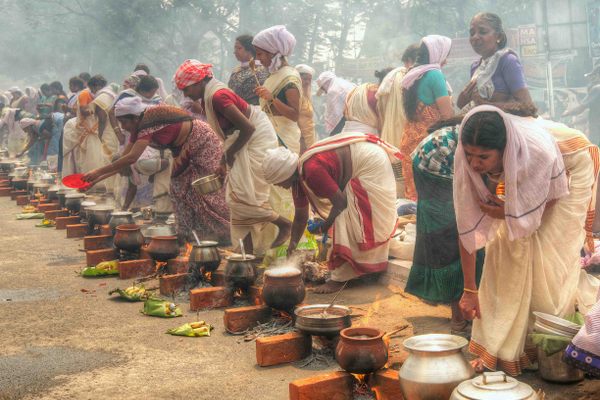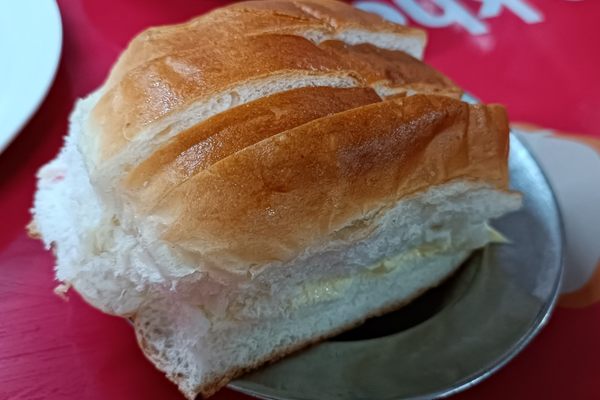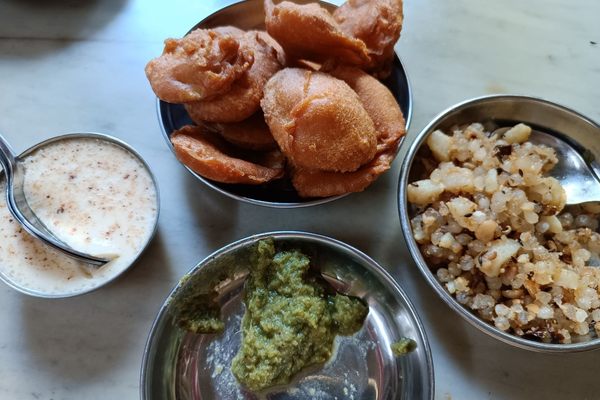Temple Wall Recipes Reveal a Wealth of Unexplored Culinary History
Medieval epigraphs carved in stone offer a unique glance at South Indian cuisine.

Today, making a donation might land you a tax deduction, but in medieval South India, it would likely be an occasion to have your name carved into stone. During the Chola period, temple walls served as a slightly more permanent community bulletin board, except carved by hand and written in Tamil, one of the longest languages in the world. Announcements and public records that made it onto the temple included government mandates, sales of properties, and temple finances—including, most importantly, records of donations given by worshippers.
Researchers have been studying these medieval, temple-wall inscriptions for years, parsing through thousands of epigraphs to piece together financial accounts of medieval South Indian history. But Andrea Gutiérrez, who studies South Asian foodways at the University of Texas, saw the writing on the wall a little differently. Some of these inscriptions, Gutiérrez argues, have something baked into them: They are, in a sense, recipes. Though donations could be general offerings, often for anointing, bathing, or decorating gods, many were intended to be put towards naivedya, food offerings prepared for, and served to, the temple god.
According to Gutiérrez, suddhannam, or boiled white rice, was (and continues to be) the “naivedya par excellence,” since it was one of the most highly-valued foods in medieval South India. Countless inscriptions dictated suddhannam provisions, often giving no specific instructions or recipes. This tends to be the case with many inscriptions, Gutiérrez notes. The dishes were often common, and the temple cooks well-versed in naivedya, so no further details had to be given beyond the name or quantity of the dish.
But medieval naivedya could take many forms. Some dishes, such as suddhannam, are presented daily, while others, such as jaggery rice fried in ghee, would be reserved for festival days. Some inscriptions cover standard offerings, while others go into elaborate detail as to which ingredients ought to be used. As a general rule, the larger the donation given, the more stipulations for expensive ingredients, perhaps more ghee or unrefined sugar.
In India and beyond, sugar played a significant role in medieval temple offerings. As Gutiérrez pored through thousands of inscriptions, she was struck by their sweetness. Nearly every dish involved sugar, including vegetable dishes and sour curries. In some cases, the dish might call for jaggery, an unrefined variety that would have been easier and less costly to access and prepare. But often, she found, temple recipes specified using carkarai, a somewhat refined brown sugar that required more skill, labor, and processing to produce. This added some flavor to the dish, and perhaps a bit of texture to pan-fried foods. But above all, Gutiérrez says, it was a marker of value. “Sugar is … worth offering to god simply because it is sweet and good, like the divine experience,” she writes. “Offerings to god should be sweet, even when savory!”

Though they detail food offerings to deities, these inscriptions illuminate much more than sugar-laden medieval fare for the gods. According to Gutiérrez, they also offer a unique glimpse into the quotidian culinary lives of those living in South India from the 10th to 13th century. Until now, much of what we know about South Indian food during this period has come from royal cookbooks, which detail luxurious dishes prepared for nobility. But, as naivedya was often everyday fare, or perhaps a slightly sweeter version of it, these temple recipes likely represent culinary trends and traditions across a much broader demographic.
“What you feed to god should also be what is fed to humans,” says Gutiérrez, “so there’s more of an aspect of normalcy to it.” Temple food known as appam, such as flat pancakes and steamed or fried sweet snacks, were, and are, both sacred fare and common street food. “For the most part, these are dishes you could also find in food stalls and on any number of people’s kitchen tables for breakfast or lunch.”
While the dishes were not always luxurious, elaborate, and rare, the occasion for the donation often was. According to Gutiérrez, worshippers often made naivedya donations to commemorate a milestone or event of great importance, and brief accounts of these moments are sometimes included in the inscriptions. Gutiérrez describes her delight when she found an inscription that explained how a chieftain made a food offering to mark the first feeding of solid food to his infant son, a Hindu rite of passage still celebrated today. “This is where you really get to have fun,” she says, “when, along the way, you learn something about someone’s daily life, and what really mattered to them.”
Deep care and personal connection to the dishes served to god is an important part of Hinduism, Gutiérrez notes, particularly in South India. Many naivedya offerings detailed in these temples resemble contemporary temple food, prasad, which is first fed to god as naivedya and later served to worshippers, a common practice in Hindu and Sikh temples.
Gutiérrez found one particular recipe for an elaborately flavored appam carved into stone at the Srirangam temple that she recognized as an early predecessor of contemporary appam still served there today. The Tamil inscription called for seasonings such as pepper and cumin, along with unrefined sugar, banana, and coconut. “That something like this is still served, 800 years later, is pretty remarkable,” she says. “It’s prepared a bit differently … but it would be weird if people were eating the exact same thing hundreds of years later.”

According to Gutiérrez, descriptions of pongal appearing early in the inscriptional record sound similar to that which is still served in thousands of temples as prasad, as well as during the Pongala festival. “It’s pretty much identical, though today people will sometimes add cashew nuts,” she says, noting cashews weren’t introduced to India until a few centuries later. But if you’re craving authentic medieval South Indian temple food, she notes, there are still traditional temples that don’t use ingredients from the Western Hemisphere, such as tomatoes, chilis, and cashews.
“These temples, themselves, are sites of historical preservation,” says Gutiérrez. “You can step inside and experience food that tastes similar to how it would have tasted several hundreds of years ago.”
Gastro Obscura covers the world’s most wondrous food and drink.
Sign up for our regular newsletter.



























Follow us on Twitter to get the latest on the world's hidden wonders.
Like us on Facebook to get the latest on the world's hidden wonders.
Follow us on Twitter Like us on Facebook